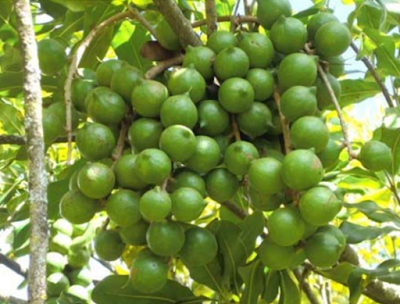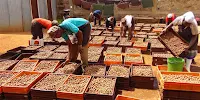Have
you noticed that there is renewed energy in macadamia production by farmers in
Kenya? This is because the agribusiness trends in the country are nowadays
influenced a lot by the export market.
 |
| Macadamia farming activities in Kenya |
The
demand for these nutritious nuts and their products is on a sharp rise
worldwide. Our country is reacting by exporting more of the produce; that is
why processing companies have set up shop in Murang’a, Embu, Taita Taveta and
now expanding to Bungoma.
Is this the right time to invest in Macadamia farming?
Yes,
this is actually the best time to invest in commercial production of this brown
gold. So far, the country has over 30 industries buying the nuts from farmers.
Most of them simply process the produce for export. That means there is now
ready market for your produce.
Read Also:
 |
Macadamia Is the Cash Crop to Farm in Kenya in 2020 and Beyond
A few years back, no one could imagine that macadamia farming in Kenya would one day be as rewarding as it is now. A few macadamia trees...
|
And
it is a fact that the farmers currently producing macadamia in Kenya do not
have the capacity to satisfy the demand from these processing companies. That
is why the price is currently on an upward trend.
How long does grafted macadamia take to mature?
Grafted
macadamia trees start fruiting after 2 years and reach an economic production
in the third year. At this time, a tree would give you 20 to 30 kilos of nuts
per harvest. The production increases steadily over time and by the 7th
year, each tree should give an average of 100 kilos per harvest. Buy grafted macadamia seedlings from Richfarm Kenya.
The
rate at which your tree grows and reaches maturity (full production) is also
dependent on how well you water it and feed it with the right minerals.
Macadamia trees require a lot of water especially in the hot areas since they
have a high transpiration rate – losing water through the leaves.
Where are macadamia best grown in Kenya?
Macadamia
nuts are mainly grown in the central part of Kenya such as Muranga, Kiambu,
Kirinyaga, Embu and Meru. These are the places that the tree was first
introduced when it came into Kenya. With time, the tree has spread to other
areas of the country such as Bungoma, Kakamega, Kitale, Machakos and Taita Taveta.
Macadamia
trees, especially the Muranga 20 variety, are highly adaptive to different
climatic conditions. As such, they can be grown in most parts of the country. However,
the cooler and rainy areas seem to be more favorable. The key ingredient in
successful macadamia farming in the lower parts of Kenya is irrigation. The
trees will need a significant amount of water especially when they are young in
order to grow well.
How much do macadamia nuts fetch in the Kenyan market?
While
macadamia are the most expensive nuts in the world, it is unfortunate that
Kenyan farmers are not yet being paid fairly for their raw nuts. A kilo of the
nuts was bought at the highest price of Ksh 230 at the close of the harvesting
season in 2019. This is much lower compared to what farmers in other places in
the world get. For example, farmers in Australia earn as much as Ksh 600 per
kilo of raw nuts.
Read Also:
 |
Macadamia Prices in Kenya to Possibly Climb Over Ksh 200 Per Kg In 2020
The harvesting season is set to start in February and the already lucrative macadamia farming agribusiness sector has all indications of rewarding...
|
So is macadamia farming in Kenya profitable?
Well,
the macadamia farmers in Kenya still make some good amount of money as profits.
We could do a quick calculation here: Mature macadamia trees produce an average
of 100 kilos per year. An acre holds about 80 trees hence a total production of
8000 kilos per acre in a harvest. If this farmer sells their produce at an
average of Ksh 150 per kilo, he will have a turnover of Ksh 1.2 million. The
cost of maintaining a mature macadamia orchard will hardly get beyond Ksh 100,000
so the farmer has a cool million to walk home with.
How much water do macadamia trees need?
In
Kenya, farmers essentially produce macadamia without ever having to irrigate
them. But of course you know what that means: their yields are always below the
optimum.
For
optimum production, a macadamia tree will need at least 40 liters of water
every day throughout the flowering and fruiting period. Irrigation should be
stopped when the nuts mature to allow them to harden off. This is a critical
fact that anyone seeking to commercially produce macadamia in hot areas that
have rains below 800 mm annually.
Which is the best macadamia variety in Kenya?
We
consider Muranga 20 the best variety of macadamia in Kenya. This is because it
adapts well to both cool and hot climates and yield just as high in whichever
climate you plant it. The nut quality and weight is also higher compared to
other varieties. Its vigorous growth also means that the farmer does not have
to wait for so long before getting their first fruits.
Read Also
 |
Farmers Make More Money With The New Muranga 20 Macadamia Variety
Macadamia farmers in Kenya were a happy lot last year (2019) as the prices went to a high of Sh200 per kilo. But some farmers were smiling more than...
|
Macadamia
farming is rather a secure form of investment: it will call on your attention
less often than most other crops and is definitely a life-long income
generator. We have helped a good number of people establish their macadamia
farms and you can also reach us on 0724698357 to have yours started.
















